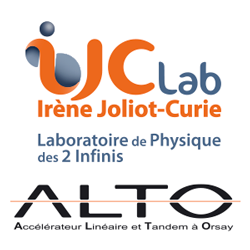Contact : M. Lebois matthieu.lebois@ijclab.in2p3.fr
Mise en service avec faisceau radioactif en 2016.
MOTIVATION
Global properties of b-decay such as half-life (T1/2) and probability of beta-delayed neutron emission (Pn) can provide the first hints on the structure of exotic nuclei. While it is in general difficult to exploit integrated quantities like P1n (or half-lives, masses …) for nuclear structure proposes, their measurements for a series of (Nm+1, 2, 3) nuclei can really be hoped to bring new insights on the structure of the closed (or supposedly closed) shell region in question. These integrated quantities are in general the first available for very exotic nuclei, because their measurement are achieved using high sensitivity or high efficiency detectors. In those conditions they can be truly viewed as a first step toward spectroscopy. In addition, b-decay properties are crucial input parameters for astrophysical models of the rapid neutron capture-process (r-process). A carefully characterized neutron detector to study the properties of exotic nuclei is therefore indispensable.
METHODOLOGY
In its neutron detection mode the BEDO detector assembly comprises a 4πb plastic scintillator counter, a HPGe detector and TETRA : a set of 80 3He filled neutron packed into a moderator matrix. The 3He long counter TETRA was built at JINR Dubna, moderator and shielding structures were built at IPN Orsay. For optimizing the coupling of TETRA to the BEDO decay station, a series of MCNP simulations was performed [2]. The efficiency of TETRA was measured to be 53 (2) % using a 252Cf spontaneous fission source, consistently with the results of simulations. The on-line performances of the system were tested with a laser-ionized beam of 82Ga, for which T1/2 and P1n values are well established. We obtain P1n(82Ga) = 22 (2) % and T1/2(82Ga) = 0.604 (11) s in excellent agreement with the literature. We have also demonstrated the ability of TETRA to be used as neutron trigger for b-decay γ-spectroscopy despite the inherently slow neutron registration process. The detailed on-line characteristics and performances of TETRA have been published in [3]. Since year 2015, the TETRA array is installed on a new, dedicated beam line parallel to the BEDO line and is coupled to the Strasbourg (VS3) Fast Tape Station prototype. This allows performing investigations on b-delayed γ-spectroscopy and neutron emission probability during the same experiment and using the same beam at ALTO.
PERSPECTIVE
the TETRA integrated data acquisition system is designed to make TETRA a tool of choice for detection of high multiplicity neutron events. This feature will be important for the upcoming experiments with beams of neutron rich-nuclei for which larger Qβ values result in higher multi-neutron emission probability. We have also demonstrated the ability of TETRA to be used as neutron trigger for β-decay g-spectroscopy despite the inherently slow neutron registration process. A new digital DAQ will be used and the signal of every single 3He cell among the 80 cell will be recorded in a trigerless mode.
PUBLICATIONS
Pygmy Gamow-Teller resonance in the N = 50 region : New evidence from staggering of β-delayed neutron-emission probabilities, D. Verney et al., Phys Rev C 95, (2017) 054320
The 3He long-counter TETRA at the ALTO ISOL facility, D. Testov et al., NIM A, Volume 815, (2016) page 96













